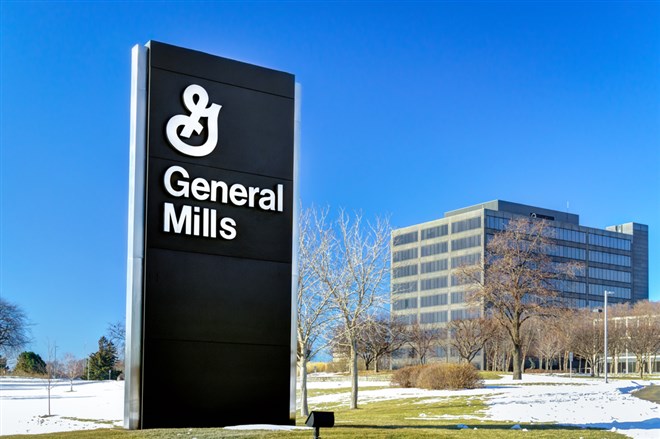
If consumer staples don't thrum the underlying drumbeat of the markets, then what other sector does? The consumer staples sector includes staples that people need to live, including food, beverage and tobacco as well as household and personal products. They might be one of the best types of sectors to invest in because they comprise businesses that are less sensitive to economic cycles.
You've likely heard of General Mills Inc. if you've ever been a fan of breakfast cereal, but it has more tricks up its sleeve. The company manufactures frozen pizza and even dog food.
Despite a highly volatile operating environment, General Mills Inc. has most recently experienced a net sales increase of 4% to $4.7 billion and organic net sales up 10%. Operating profit increased 29% to $1.1 billion. Diluted earnings per share (EPS) increased 32% from last year. Finally, General Mills Inc. has raised its full-year fiscal 2023 outlook.
What does all this mean? Let's take a quick look at what you need to know about General Mills Inc. and the pros and cons of investing in the company.
About General Mills Inc.
General Mills, originally called the Washburn “B” Mill, got its start as a flour mill on the Mississippi River by Cadwallader Washburn. Later, Washburn "A" Mill was built and
Washburn-Crosby flour topped U.S. brands, renamed as Gold Medal flour later on. In 1928, General Mills became an official company and was known in its early days for the following products and brands still on the market today: Bisquick, Kix, Cheerios and Betty Crocker. General Mills moved its way into many different areas over the years: aeronautical research, the toy industry, restaurants, clothing and apparel, games and more.
General Mills, Inc. manufactures and markets branded foods worldwide, including the following types of foods:
- Ready-to-eat cereals
- Yogurt
- Soup
- Meal kits
- Refrigerated and frozen dough products
- Dessert and baking mixes
- Flour
- Frozen pizza and pizza snacks
- Snack bars
- Fruit
- Salty snacks
- Ice cream
- Nutrition bars
- Wellness beverages
- Savory and grain snacks
- Organic products
- Pet food products (including dog and cat food)
The company markets its products under the following brand names (hold on, it's a long list!): Annie's, Betty Crocker, Bisquick, Blue Buffalo, Blue Basics, Blue Freedom, Bugles, Cascadian Farm, Cheerios, Chex, Cinnamon Toast Crunch, Cocoa Puffs, Cookie Crisp, EPIC, Fiber One, Food Should Taste Good, Fruit by the Foot, Fruit Gushers, Fruit Roll-Ups, Gardetto's, Go-Gurt, Gold Medal, Golden Grahams, Häagen-Dazs, Helpers, Jus-Rol, Kitano, Kix, Lärabar, Latina, Liberté, Lucky Charms, Muir Glen, Nature Valley, Oatmeal Crisp, Old El Paso, Oui, Pillsbury, Progresso, Raisin Nut Bran, Total, Totino's, Trix, Wanchai Ferry, Wheaties, Wilderness, Yoki and Yoplait.
Pros and Cons of Investing in General Mills Inc.
What are the pros and cons of investing in General Mills Inc? Let's take a quick look.
Pros
First, the benefits of considering this long-standing company:
- Dividends: The company has a 2.77% dividend yield, an annual dividend of $2.16 and a dividend payout ratio of 45.47%. This means it has a healthy payout ratio; it should cover its dividend payments with earnings for the next several years. The company has also bought its own outstanding shares through a buyback in order to reduce the number available on the open market. General Mills has reduced the total number by about 7% in the last decade. It can show that the company believes it is undervalued.
- Powerful brand: The company is a powerful brand with stability that has continued over decades. The brand also sells its products in a wide variety of ways, including directly and through broker and distribution arrangements to the following:
- Grocery stores
- Mass merchandisers
- Membership stores
- Natural food chains
- E-commerce retailers
- Commercial
- Noncommercial foodservice distributors and operators
- Restaurants
- Convenience stores
- Pet specialty stores
- Drug, dollar store and discount chains
- Historic high performance: Consumer confidence has always generally been high with General Mills. Low or declining consumer sentiment can indicate that the company doesn't want to spend large amounts sums of money on nonessential goods and services.
Cons
What are the downsides of investing in General Mills Inc.? Let's look at the reasons you may want to steer clear of the stock:
- Competition: There's no shortage of General Mills Inc. competitors, including Kraft Heinz (the main competitor of General Mills Inc.), Kellogg’s, Conagra Brands, Mondelez International, Hershey, Nestle, Ingredion, Michael Foods, Campbell’s, DPS, Smucker’s, Quaker Oats, Tyson Foods, Diageo, Hormel Foods.
- Low PEG ratio: The company's 12-month-forward PEG ratio of 2.65 is poor GIS in relation to the company's projected earnings growth due. The company's PE and PEG are worse than the market average and include a below-average valuation score.
Will You Consider General Mills Inc. for Your Portfolio?
It's a good plan to select investments that are not affected by market sentiment. General Mills has a strong track record of performing well even during downward economic changes. It has proven its value time and time again through its dividend payments and share buybacks. It has a wide distribution network based out of its headquarters in Minneapolis, Minnesota. However, it's important to consider your overall portfolio and risk tolerance before you make a final decision.
Since financial planning can be complicated, you may benefit from specific advice from a fiduciary financial advisor. (Ask how they get paid when you interview suitable advisors.) It's a great idea to work with a financial advisor and then meet with them every five to 10 years as well as right before you retire so you know you're doing exactly what you should in order to retire the way you want to.













